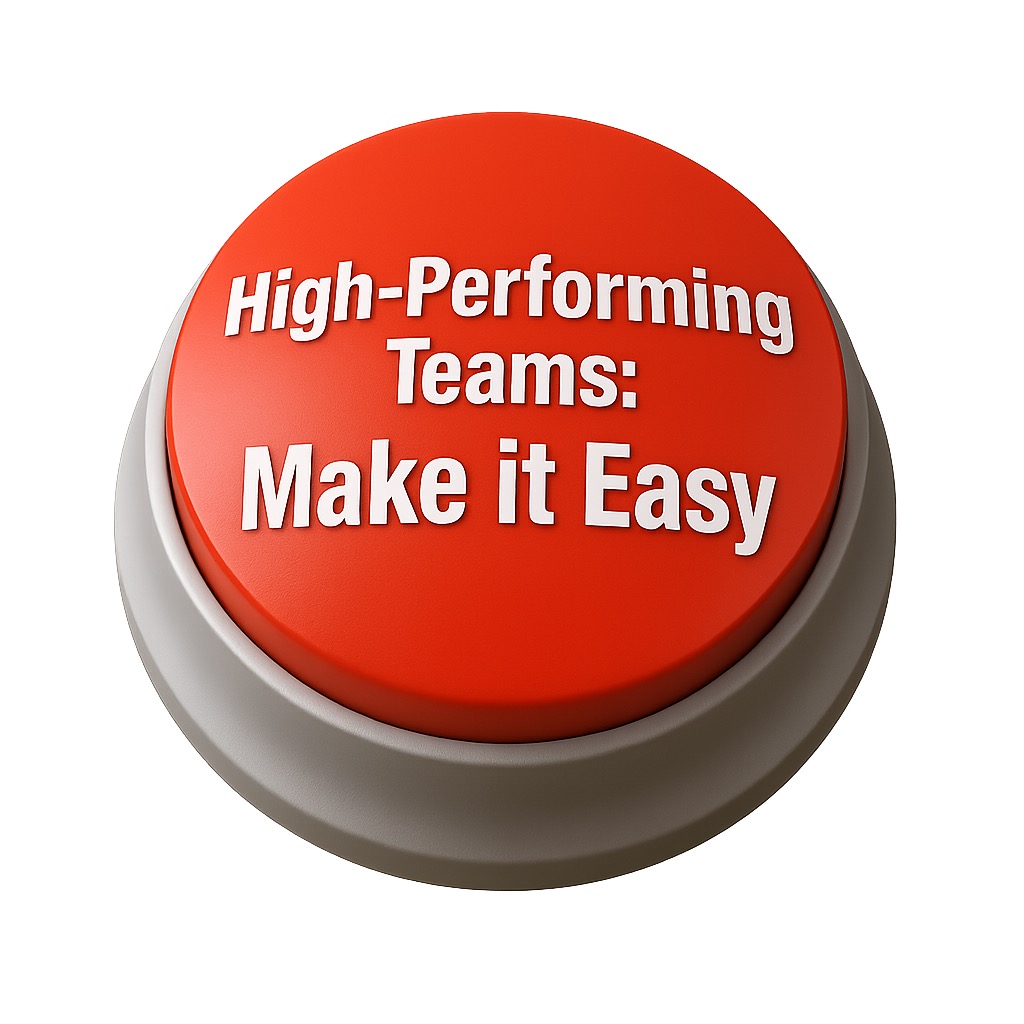Leaders create the ecosystem where teams can thrive and succeed. My article, “Simple Rules for High-Performing Teams,” describes how managers can build productive, committed, and innovative organizations where collaboration is the norm. Simple rules are universal principles that are easy to remember, apply, and more likely to be followed.
To create high-performing teams, managers should:
- Create psychological safety,
- Empower the team, and
- Make it easy.
Previously, I delved into creating a culture of psychological safety. This article focuses on “making it easy.”
Making it easy means creating an environment that enables high performance. As Deming said, “A bad system will beat a good person every time.” The management and operational systems—broadly defined—establish the boundaries and expectations that govern enterprise, team, and individual interactions. They motivate and incentivize the behaviors that build the team’s culture.
Use Systems Thinking
Systems thinking is a way to understand complexity. It focuses on the connections and interactions among a system’s parts. Organizations and teams are complex systems. Improving performance requires understanding how everything works together and influences team dynamics and effectiveness; this includes policies, standards, procedures, and informal cultural norms.
Toyota applied systems thinking when designing its production system. It created a comprehensive ecosystem dedicated to manufacturing high-quality cars. The production process was optimized not only to deliver vehicles but also to encourage employees to prioritize quality.
A typical production line operates at a fixed speed. If a worker misses a beat, a lower-quality item is sent to the next workstation. Defects are addressed after the final inspection. Workers are primarily motivated to keep pace. Problems are handled later. This system favors speed over quality.
Toyota installed a cord along the production line, enabling workers to stop the line and fix a problem rather than allowing it to continue. The cord is pulled thousands of times daily. This system favors quality over speed, fostering a culture of empowerment, respect, and trust.
One of the principles in the Agile Manifesto is, “Simplicity—the art of maximizing the amount of work not done—is essential.” Unnecessary process steps are common in most organizations. Multiple reviews and approvals are put in place to provide oversight and control. However, the result is often the opposite, creating unnecessary complexity and diffusing ownership and accountability.
Make it Easy
Making it easy involves assessing every aspect of our organization and asking whether the environment and systems enable our teams to be their best. There are many ways to evaluate these factors. One approach is to examine people, processes, technology, and relationships, which are common sources of organizational friction. When applying systems thinking, we can see the interconnections and influences on team behaviors.
People
Not surprisingly, who we hire, how we organize, and structure our teams greatly influence their performance. In “Good to Great,” Jim Collins describes the importance of “getting the right people on the bus,” putting them in the “right seat” (role), and having a clear destination (strategy). This alignment is a recipe for success. Collins asserts that people are more important than strategy.
Roles, titles, and perceived hierarchies influence team performance. Scrum teams only have three named roles: the Scrum Master, the Product Owner, and the Team. The Scrum Master and Product Owner have specific responsibilities, while the Team collectively is responsible for developing and delivering the solution. Jeff Sutherland, the co-creator of Scrum, cites research from Bell Labs that found that the most effective teams had the fewest number of roles.
Smaller teams are more productive than larger ones. Amazon favors 2-pizza teams. Teams that can be fed with two pizzas. We see similar configurations in the military, sports teams, and Agile teams.
People are central to success: simplify the organization. Get the right people on the team and establish a clear mission. As the Agile Manifesto states, “Build projects around motivated individuals. Give them the environment and support they need and trust them to get the job done.”
Process
Processes and systems shape behaviors and culture. Deming estimated that 94% of improvement opportunities come from changing the system, not the people. Systems with rigid rules, multiple handoffs, and escalation points limit creativity and innovation. Open communication, collaboration, and ownership are influenced by process design and culture.
Think about the typical customer service experience where you are passed from one person to another. Now, consider the opposite scenario, where your first contact is empowered to resolve the issue. It makes a huge difference for both you and the service representative.
Technology
When technology becomes invisible, teams can focus on what really matters—creating value. Technology should enable the process and make things easy for the team. However, sometimes the technology gets in the way. It makes it difficult for teams to work effectively.
In the classic DevOps book, “The Phoenix Project,” the team was stymied by its IT help desk ticketing system. The solution was to print the tickets, then prioritize and organize them on the conference room wall. Visualizing work makes it easier to understand.
Carefully plan the technology. Pick solutions that meet the needs. Consider how the tech enables the process and affects team dynamics. Periodically evaluate. Does the technology support the culture we want?
Relationships
Management sets the operational structures and practices that determine how teams interact. Foundational choices —such as organizing principles, compensation, and even physical space —greatly influence team performance. These choices can either facilitate or hinder teams’ ability to engage, collaborate, and achieve high performance.
Collaboration is a core value at Apple. Its campus in Cupertino was intentionally designed to foster serendipitous interactions. Apple wanted employees to bump into each other and have conversations that would cross-pollinate new ideas. Workplace design impacts how teams engage and collaborate. Allen’s Curve shows how engagement drops as people sit farther apart from each other.
Organizational structures—functional, projectized, or matrix—shape how teams operate. Functional teams are usually long-standing and have a greater likelihood of becoming high-performing. Project teams typically disband once the project ends, making it harder for members to build strong bonds. However, when conditions are right, these teams can develop a clear mission and a strong sense of purpose. Because members are split among multiple teams, matrix orgs find it harder to become cohesive.
Reward and compensation structures heavily influence behaviors and performance. Bonus structures that focus on individual performance are detrimental to teams that require collaboration. Many consulting and technology organizations changed their performance and compensation programs to shift focus from individuals to teams.
To build and maintain high-performing teams, leaders must manage competing priorities. Simplifying processes and structures creates opportunities for teams to work more effectively.
© 2025, Alan Zucker; Project Management Essentials, LLC
See related articles:
- Creating Accountability
- Culture and Successful Projects
- Empowering Your Teams
- Simple Rules for High-Performing Agile Teams
- Simple Rules: Psychological Safety
- The Cookie Post…Great Leadership
To learn more about our training and consulting services or subscribe to our newsletter, visit our website: http://www.pmessentials.us/.
Image generated by ChatGPT

